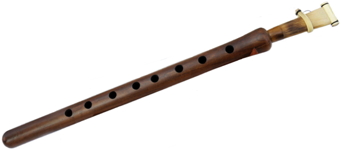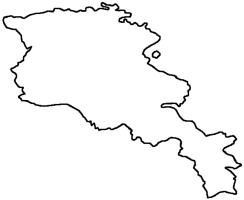
|
The Society of Folk Dance Historians (SFDH) Armenian Musical Styles
[
Home |
About |
Encyclopedia | CLICK AN IMAGE TO ENLARGE |

|
By Forrest Johnson. Used with permission.
When the Armenians left Anatolia earlier this century (let's not get into why!) they settled all over the world. Most of these Armenians were from historic Western Armenia. They danced to davul-zurna music. After settling in their new homes in various parts of the world their music and dance began to change. Many Armenians settled in Lebanon and were influenced by "Mid-East" music of that area of that time (Levantine). As you noted this music was not traditional Anatolian (10/8, 7/8, 9/8, etc.).
Because of the recent past troubles in Lebanon many of the Christians (Armenians) in Lebanon have emigrated to America . . . especially Southern California. The Armenians from Lebanon dance to the more modern sound you have described while the "Armenian-Americans" living in this country from the time of the initial emigration from Anatolia (1900-1920's) have continued traditional line dancing to a more modern sound of a full orchestra . . . oud, clarinet, dumbeg (a goblet drum), bass guitar, and sometimes a kanoon (a string instrument). The dances have changed too, but they are still mostly line dances. The Armenians from Lebanon< would probably be doing couple dances to what sounds more like rock or Latin music! Remember . . . what is important is . . . location, location, location.
–Forrest
We have recently had some Armenians from Central Asia emigrate to Milwaukee after the collapse of the Soviet Empire . . . their music sounds Russian and their dances look Russian...and they drink lots of vodka! Location, location, location . . .
I asked Lynn Kaishian about the veils . . . she said that it went back over the head . . . they never wore it over the face!
Differences between Armenians in Europe, the Mideast, and America are attributable to the differences of Eastern and Western Armenian dance and music (most of Armenians coming to America during the genocide came from Anatolian Armenia).
Ara:
Tom Bozigian early in his folkdance teaching career co-produced some 45 rpm recordings with Bora Özkök. It was natural for an Armenian and Turk to produce such recordings. Yes it is natural; both Armenians and Greek depend on Turkish music.
Bozigian:
This is not a fair statement. Armenians and Greeks do not 'depend' on Turkish music. The Armenians, Greeks, Turks<, and other ethnicities wove all their sounds together. To say that Tom Bozigian depended on Bora Özkök for the music is not a fair statement and in my opinion untrue. Every ethnicity depended on each others music. It would not be fair or accurate for me to say that the Turks were dependant on Udi Hrant. Same rule applies.
Ara:
Now because I heard the keyboard sound, should I dance differently, or invent (make up) a dance, (or open a contest as Armenians did)?
Bozigian:
Since when are Armenians in a contest to make up new dances? I have performed at Turkish dances where the people dancing are not dancing the "true" dance to the song composed. So what? A 9/8 karsilama can be performed many different ways. Which form is right?
Ara:
The Armenian-Turkish composer of Siroon Aghcheek, Udi Hrant was born in İstanbul in 1901. Among his many recordings only three (including Siroon Aghcheek) was in Armenian. It was recorded in İstanbul in 1950s, with Sukru Tunar on clarinet, Ahmet Yatman on kanun, and Ali Kocadinc on percussion. It never occurred to Hrant that his composition would turn into a folk dance tune in the Unites States; he had nothing to do with eastern Anatolia nor was he a village musician.
Bozigian:
Correction, only three were sung in Armenian. Many of his compositions were about the Armenians. If you are saying that only three songs were sung in Turkish, I would agree with you.
Ara:Although the Armenian population varied locally (for example in 1897 Armenians comprised twenty-five percent of the city of Kars) the average Armenian population in eastern Anatolia was twenty-two percent. Is it possible that such a minority had some but not many dances to lose, and hence the need to expand their repertoire?
Bozigian:
I was not under the impression that the >Armenians were considered a minority in those times. Quite the opposite I have learned. I do not think the Armenians felt any desire to add to their dancing.
A comment or two on the "creation" of Armenian dances:
Its very likely that the Armenians diaspora resulted in a loss of original dance material among the Armenian-Americans. Certainly leaving village and small town settings and coming to the ever work driven United States forced a change in focus among those who immigrated, leaving little time for music and dance in a new society. This is true of nearly every ethnic community who immigrates from their native land. Despite the large number of Vanatsee Armenians in Detroit, very little remains of their dance repertoire which, I am told, was very rich hrough the middle of this century. (The original Vanatsee immigrants who might still remember these dances are now eighty or ninety years old.)
Additionally, the move from smaller villages to larger industrial centers would have lead to a more established dance repertoire done in social settings: what we now regard as pan-Armenian American dances such as Pompouri, Halay, Laz Bar, Sepastia Bar, etc., which definitely had an origin in Armenia, but took on a standardized form here (though there are variants to all these dances, their core is essentially Armenian).
My understanding from many sources is that the creation of new dances in the 1950s result is that a good many dances were created, though largely derivitives of an old style and base vocabulary of steps. This evolution of dances continues today as I have seen many permutations of the California Hop, Michigan Hop, Shiekhani, Shuffle, etc. New forms seem to constantly be created though the structural and rythmic contexts remain pretty consistant. This is, after all, "folk dance." To regard, one form as real, and another as not, or one form as really Kurdish, Turkish or >Greek, becomes rediculous as people who claim dances as part of their own culture, inherit them.
Forrest:
Thank you, Shawn, for your reply and additional information. Your Polish bar sounds very much like a club that operated in Shorewood (Milwaukee suburb) for several years . . . Stolichny's. It was managed by an Armenian and frequented by Jews from Russia. The food was unusual (for us), the smoke was heavy, and the music and dancing was a cross between Rock n' Roll and Vamp?! It was all couple dancing . . . not folk as we think of it.
The Armenian line dancing as done today in America and Canada is "not really Armenian<" (Tom Bozigian<'s words), but really Armenian-American. When the Armenians emigrated to North America earlier this century they brought with them all their village dances done to davul-zurna music. They often settled together with people from their own region of Historic Western Armenia. When they would have picnics and other gatherings they would continue to do their old village dances.
During the late 1940s – early 1950s a new generation of Armenians<, or Armenian-Americans, began dancing new dances to a new sound. The clarinet replaced the zurna, the dumbeg replaced the davul, and an oud and guitar (bass) were often added. They danced new Armenian-American dances to the old tunes played by new orchestras. Gone were most of the old, "real Armenian," village dances from Anatolia.
Many of these new Armenian-American dances were created by Armenian-Americans at contests to develop such dances.
Yes, Tom Bozigian, early in his folkdance teaching career, co-produced some 45 rpm recordings with Bora Özkök. It was natural for an Armenian and a Turk to produce such recordings as these people listened to the same music and danced the same dances in Eastern Anatolia before the mass exodus of the Armenians> (1900-1920). There are no Western Armenians left in Eastern Anatolia . . . so there is really no one doing "real Western Armenian folk dances" except performing groups and perhaps some international folk dancers. Turkish populations in these areas could still be doing these dances. Eastern Armenian dances from the area of what is now the Republic of Armenian have always been more related to Caucasian folkdances . . . similar to Georgian< folk dances, etc. It's that location thing again!
I don't know if this has helped any, but I tried.
P.S. At the risk of offending Ara . . . for my sake, please add "kanun" (a string instrument) to the list of instruments in the "new" Armenian orchestra. These new orchestras developed a ">Mid-East" sound.
Ara:
You're right, Forrest, on your comments about Armenian dancing. Tom Bozigian, a native from Detroit, is also correct in his analogy on line dancing in the United States by the Armenians. In Armenia and Turkey, dancing is a whole other matter.
Thanks for including kanun in the list of instruments in Armenian bands! Actually, the kanun came before the clarinet (which is considered the lead in Armenian bands in America playing folk music) during the turn of the century. The bands consisted of kanun, violin, oud (on occasions), and drum set.
In this country we are dancing Armenian-American dances which had a base in Western Armenian dancing. Tineke van Geel's dances are Eastern Armenian dances. The music and the dances are different. The dances look more like those of the region (Georgian-Azeri, etc.) than anything Western Armenian.
DOCUMENT
- Armenia, a country.
This page © 2018 by Ron Houston.
Please do not copy any part of this page without including this copyright notice.
Please do not copy small portions out of context.
Please do not copy large portions without permission from Ron Houston.
